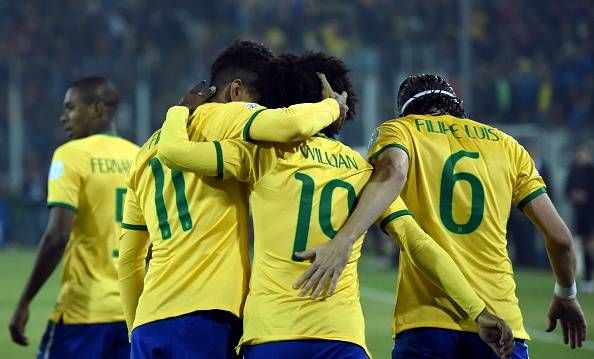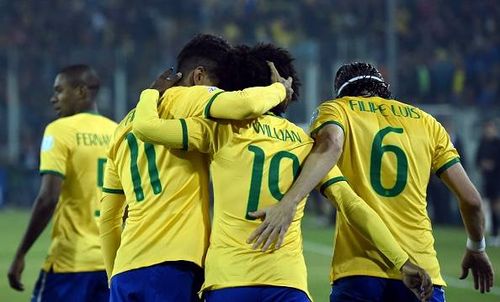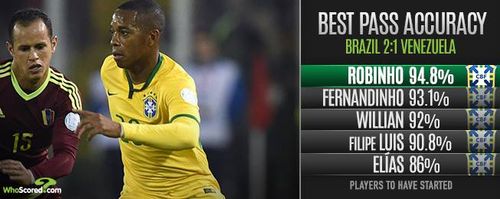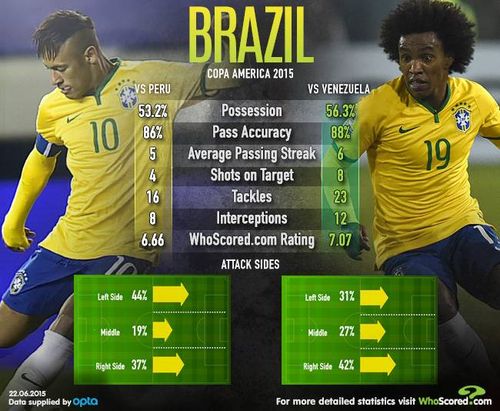
The two sides of Brazil against Venezuela

Dunga has made a few surprising decisions during this Copa America and, after his Brazilian side had finally claimed a place in the quarter-final, he also came out with a curious comment.
“Now, we have to play to win.”
The wonder is how he would describe what they have been doing so far, especially since Dunga’s own ruthlessly pragmatic attitude ensured they ended a game against mere Venezuela with four centre-halves on the pitch and Elias desperately booting the ball into an empty opposition half in order to preserve a 2-1 lead. The Brazilian boss is notoriously single-minded about such things but even this seemed an extreme.
So, what does he have in store? What do his team have in store?
The reality is that this was a performance that reflected the side, one filled with contradictions where the exact level is unclear.
Take the fact that, for around 70 minutes, this was Brazil’s best performance of the Copa America so far and it came without their best player. They certainly didn’t seem to feel the loss of Neymar as Thiago Silva powered Brazil into the lead after just 11 minutes, and the side seemed oddly more cohesive.

The stats compared to a similar game, the opening 2-1 win over Peru, reflect that balance. Brazil had more players offer at least two key passes, and were able to go through the centre much more - 27% of the play rather than 19%. They also had more shots on target, eight to four, and had a higher average streak of passing at six against five.
Literally central to this was Willian, who seemed emboldened by the fact he was one of the key players rather than just serving someone superior, as has been the case for so long both with Brazil and Chelsea.
While it was the purpose of his runs that so often caught the eye, it was the perception of his passing that so often caught Venezuela out, as the attacking midfielder played five key passes. The best of them was a beautiful outside-the-foot effort that set up Roberto Firmino for the ultimately crucial second goal.
Willian also linked up supremely with Robinho, who seemed to finally offer the kind of commanding and authoritative performance in a Brazil shirt that many expected a decade ago. The fact this former golden boy was also directly replacing Neymar, and all the pressure that comes with it, made it all the more impressive.
If Robinho is obviously nowhere near as devastating or simply as good as Neymar, he did liven up the team, and there was a creditable new responsibility to his role. That could be seen in moments like his pass to Willian after a run when he previously might have blazed a shot, as well as his possession game in general. Robinho basically radiated control, and it gave Brazil confidence. He played 58 passes, and 94.8% of them were accurate.
It is no surprise that Brazil began to cede so much possession and ground once he went off, but it is a surprise just how much they began to crumble.

This gave rise to another contradiction. How could a match that saw them start with such assertive football end with many of those same players looking so fragile?
By injury-time, Brazil were a panicked mess, and had to make 23 tackles and 17 fouls - both more than Venezuela, at 9 and 14, respectively.
So much for that defensive assurance. Had Venezuela goalscorer Miku been a couple of inches taller, then he might well have scored the header that brought even more tough questions for Brazil.
That made another comment from Dunga all the more curious.
“We believe now that Brazil will play better, have more capacity for that and have confidence.”
That might have been the case from the first passages of play, but certainly didn’t look that way by the end. They didn’t look confident at all.
The wonder is which Brazil we’ll end up seeing.